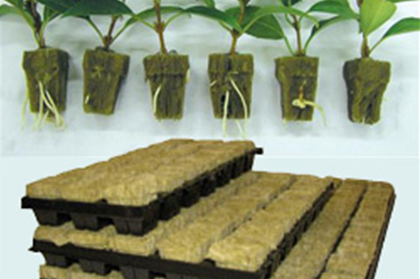About Rockwool - Growing Medium Substrate
Stonewool (rockwool) is probably the best known substrate. The fibres Mineral wool - are made by spinning a melt of basalt and limestone. This substrate is mostly used in the form of slabs. For this purpose a binding material and a wetting agent are added. However a granulate and small cubes of stonewool (e.g. for gerbera) can be used as well. The material can hold a lot of water and will release it quite easily. If, however, mineral wool has become dry it cannot simply be rewetted. The pore size distribution in this medium causes an unequal distribution of water in height. The lower part of the slab of mineral wool is almost completely saturated while the top layer can be dried out. The irrigation must be such that the slabs stay moist everywhere but saturation of the slabs should be avoided. This means balancing: limiting the irrigation can dry out some parts of the slabs and this reduces the water buffer and rooting volume. If the irrigation is such that there is too much water, the air content will decrease and lack of oxygen for the roots can be expected. Both situations should be avoided because they have a negative effect on production. From a chemical point of view, mineral wool is almost inert. Stonewool however can be affected at a low pH. The fibres will lose their stability and the medium will become pulpy and can finally collapse.

Types of Rockwool Available
Advantages
So you see that rockwool has beneficial pore space for your crops,
and it also has other qualities that make it useful for your gardening.
However, now is a good time to explain that not all rockwool is created
equal.
For example, the best horticultural rockwool is made from pure
basaltic diabase using a quality-controlled melting and spinning process
that has precise supervision of fiber size, compression, and
consistency.
It’s interesting to note that the most excellent rockwool is made by
manufacturers who understand that minerals contain mineral oils that
repel water. That means manufacturers of the best rockwool remove the
mineral oils during manufacture, and replace them with just the right
amounts and types of wetting agents that help water penetrate the
mineral fibers so the rockwool holds the right amount of water for your
plants.
Rockwool is among the most popular sterile soilless growing media that hydroponics gardeners use. For many years, rockwool was the only sterile soilless medium (or substrate) that was widely available for hydroponics growers.
Let’s take a closer look at rockwool…
The generic form of rockwool started out as an industrial material used for insulation. It was valued because it was dense but airy, lightweight, pliable, relatively easy to manufacture, and less expensive than other insulation.
When amateur and commercial hydroponics gardening became popular in Europe during the 1960’s, some brilliant innovators looked at rockwool and wondered if it could be a replacement for sand, gravel, sphagnum moss and other substrates used for plant growth.
Horticultural inventors experimented with rockwool by altering its mineral content and the process by which it’s spun, compressed and formed. Soon, they’d created an agricultural grade rockwool that had several desirable qualities.
By the way, this type of innovation is still at work today in the hydroponics industry, and it’s why you can get modernized digital ballasts, nutrients and other materials that were never available until the past couple of years.
One important rockwool quality for you is that rockwool has a porous, pliable internal structure that allows roots to easily penetrate it while also providing suitable anchoring material so your plants’ roots are firmly entrenched. Quality horticultural rockwool provides your plants approximately 13-20% pore space (the space in which oxygen can be held).
Why is pore space so important for your plants? Because your plants need to intake oxygen through their roots. One of the reasons that some substrates are unsuitable for gardening is that they lack pore space, especially when wet. The lack of pore space, combined with too much water, shuts oxygen out of your plants.
This is why overwatering is a big problem for your plants. It suffocates your roots so they can’t absorb enough oxygen. Plants need oxygen to sustain healthy metabolism. When rockwool is properly watered, it maintains adequate pore space for easy absorption of oxygen and provides your plants the water they need too.